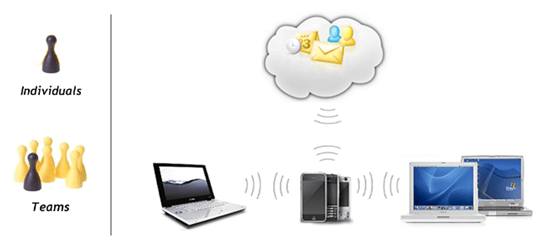Updating Your Company’s Mobile Collaboration Policy
Every year we see some more shift in mobile collaboration: employees become more mobile, workplaces are redefined, partners and customers require more mobility and quicker access. These shifts bring more pressure on the corporate IT, who is expected to match the technology adoption. Looking from the management perspective, we need to review and update our company’s mobile collaboration policy.
A mobile collaboration policy is about matching the right technology with the company’s strategy. It is allowing the employees to securely collaborate on corporate documents anytime, anywhere and from any device. And, yes, the policy is different in every organization. There are three sides of the mobile collaboration policy: data, user and the corporation.
Data
When the Bring Your Own Device (BYOD) revolution swept the corporate offices, in many companies data ownership was defined verbally. Years passed and in the majority of the companies the data ownership rules are still unwritten. If our company is the same, we have to start with writing down the rules. Then we will continue with choosing the right technology and implementing it. (If you have not started working with data ownership, I suggest you to read Will Kelly’s Review Data Ownership Before BYOD article.)
Once we have defined the ownership, we will go on with securing it. We can either use applications that are specific to Mobile Content Management (MCM) or we can utilize our Mobile Device Management (MDM) application’s security features. In some cases, for companies using Microsoft’s infrastructure, using the available tools bring the type of security that is comparable, even better than the specific applications. To say, in an Active Directory environment activating Active Directory Rights Management Services (RMS), updating SharePoint and Exchange with the RMS and employing the MDM features in System Center Configuration Manager brings a very good level of security. MCM applications, on the other hand, work fine but unfortunately they are not able to keep up with mobile users’ requirements. To see, check Airwatch reviews on Google Play Store; Airwatch is one of the top results in mobile content management query in Google search.
Then comes the data and information management issues such as metadata and mobile-specific requirements. Working on these and implementing the right management features you can allow your users to find and retrieve documents and data faster when they are mobile.
User
Identity tops the list in the user related issues. A user’s identity is more relevant to the corporation than the device; and no doubt the price of the identity is way more than the device. It is for this reason that Microsoft made identity management part of its Enterprise Mobility Management suite. Identity management comes with self service, access control and single sign on (SSO) features. Considering the variety of corporate applications – from Office suites to file share and ERP, to name a few – there needs to be an identity management back end to provide the user the level of comfort she needs to continue her job without giving her the overhead of managing all of these herself.
Corporation
The corporation will first think about the security of its information assets. Therefore using secure applications will be one of the top priorities. Office 365 from Microsoft was a true game changer in this category by having secure office applications in the users’ devices plus a secure management backend. There are also applications that provide security by sandboxing that secure the perimeter of the application. Samsung’s Knox is a good example of secure application middleware: it provides a stack that separates business and corporate applications so that the employee uses the secure business applications, which can communicate with the corporate backend and with other business applications, but not with the user applications.
The corporation on the other hand considers the efficiency of the employees; at least this is one of the reasons why the mobility is allowed. To work more efficiently, the new trend is intelligent information discovery and presentation. Intelligent information discovery is having relevant, personalized information presented to the user, without having the user to go through directory structures and advanced searches. We all know that trying to remember where the document is located in a hierarchical directory structure is a big overhead for all the users – “I cannot find the file in the folder here, where was it?” is a big time loser in our everyday life at the office. That is one of the reasons why Microsoft put it into its Office 365 suite with Delve (yes, the Volometrix acquisition is part of this, but from a “people” perspective). Huddle and Colligo are other products that are trying to present the relevant information to the user by removing the hassle of remembering where the information is located.
At this point, we have to link the intelligent information discovery to the metadata and the information management I have just talked about. If we want to increase the “intelligence” of our information discovery application, we need to feed it with the right information, especially with the correct, relevant and complete metadata. These applications work by first using the metadata that is put in place by the user and if it is not available, it tries to extract the metadata from the document. And this extracted metadata does not need to be 100% complete; for example it may skip department or workflow information that the document used by and/or belongs to. That’s why we should have a good information management infrastructure to benefit more from intelligent information discovery.
And finally, the cloud issue – personal or the corporate cloud. The corporation also has to think about securing the cloud for the mobile users, especially for a file sync and share solution. In case of a OneDrive – Office 365 solution, this issue is already solved. It is also solved by Dropbox and Box in their corporate offerings. If a cloud offering has a corporate plan, it is most likely to have a central management feature, either by a plug-in/add-on to an Enterprise Mobility Management suite or by its own management tool. It is important to review the file sync and share issues when reviewing and updating your mobile policy.
If you are considering revisiting the mobile collaboration policies, then it is obvious that you have to approach from various perspectives – strategy, technology, implementation, user and data are the main points to touch.
What are your mobile policies? Let us hear in the comments below!
References
- Featured image: http://www.hyperoffice.com/
RELATED: IT Managers: Here Are Your User Management Headaches




